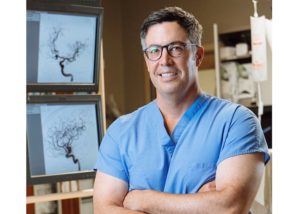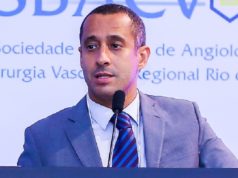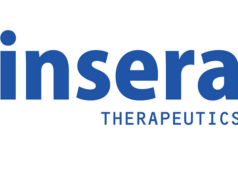
For patients with emergent large vessel occlusion (LVO) eligible for endovascular therapy, prehospital triage to a more distant comprehensive stroke centre (CSC) compared with a closer primary stroke centre (PSC) was associated with significantly shorter time to thrombectomy, better clinical outcomes and no delay to alteplase. Within a matched-pairs model, this association held true for the entire cohort, report Mahesh V Jayaraman, Ryan A McTaggart and their colleagues from Warren Alpert Medical School of Brown University, Providence, USA.
Published in the Journal of NeuroInterventional Surgery, Jayaraman et al write in their paper: “In a densely populated setting […], seven additional minutes of prehospital transport was associated with nearly an hour faster time to endovascular therapy, and a 16–26% absolute increase in functional independence.”
Between January 2016 and December 2017, a portion of the region (in Rhode Island) in which the study was conducted allowed field triage for patients who met severity criteria to a more distant CSC as opposed to the closest PSC. During these two years, 232 patients met inclusion criteria, and in turn, 144 were taken to the closest PSC and 88 to the more distant CSC.
“The median additional transport time to the CSC was seven minutes,” write the authors. They also found that times from scene departure to alteplase and arterial puncture were faster in the direct group (50 vs. 62 minutes, 93 vs. 152 minutes, respectively; p<0.001). Among patients who were independent before the stroke, the odds radio for less disability in the direct group was 1.47 (95% confidence interval [CI] 1.13–1.93, p=0.003), and 2.06 (95% CI 1.10–3.89, p=0.01) for the matched pairs. Moreover, the rate of symptomatic intracranial haemorrhage was 10/144 (7%) in the transfer group, and 1/88 (1%) in the direct group (p=0.06).
In light of the findings, Jayaraman, McTaggart and colleagues believe, “these results will drive much needed change to regional stroke care delivery, better point-of entry protocols not only save lives but every minute reduction in time to endovascular therapy is estimated to save the healthcare system more than US$1,059.”
The study investigators provide additional background to the study. “Our region has a population of nearly 1.5 million people in Rhode Island and southeastern Massachusetts, and all 16 PSC’s in our region use a standardised protocol to transfer patients to a single CSC where all endovascular therapy is performed,” they write. Yet, with a portion of the region implementing a severity-based, field triage algorithm that directed emergency medical services to bypass closer PSC’s to take patients directly to the CSC, the authors could compare the times to treatment and outcomes of patients.
The following criteria were used to identify eligible patients: a new, disabling neurological deficit (scoring ≥6 on the National Institutes of Health Stroke Scale [NIHSS]), initial non-contrast CT demonstrating lack of large completed infarction (scoring ≥6 on the Alberta Stroke Programme Early CT score [ASPECTS]), occlusion of the intracranial internal carotid or middle cerebral artery, the closest hospital from the scene was a PSC, as well as availability of clinical follow-up at 90 days.
Jayaraman, McTaggart and colleagues acknowledged that, in terms of demographic variables, there were higher rates of hyperlipidaemia in the transfer group (54% vs. 39%, p=0.02). Yet, the remainder of the demographics failed to elicit any significant differences between the two groups.
Discussing the results further, the authors write that many may argue that the results are not applicable to other regions. However, they referenced the STRATIS (Systematic evaluation of patients treated with neurothrombectomy devices for acute ischaemic stroke) registry, which includes 985 patients across 55 states in the USA, 65% of which incurred a stroke within 25 miles of the hospital where endovascular was performed, and 40% within 10 miles. Thus, they surmised: “It is likely that there are many other regions that are similar to ours.”
Regardless, Jayaraman, McTaggart and colleagues recognise that the optimal time parameters to determine triage to a more distant centre are unknown. According to the authors, a recent decision analysis has suggested that both time to CSC as well as time from onset play a role in determining an optimal triage radius, and proposed that for early presenting patients, the bypass threshold may increase up to 56 minutes. Further research to optimise the threshold for triage may be warranted, they write.
Nonetheless, based on this work and their recent research trying to optimise door-in, door-out times for LVO stroke at the regional PSC’s (McTaggart et al Stroke. 2018 Dec;49(12):2969-2974), the Rhode Island Ambulance advisory board recently voted to eliminate the 30-minute threshold from the field triage protocol—all suspected LVO patients in Rhode Island are taken directly to the CSC (Level 1) stroke centre.
In relation to particular drawbacks of the study, Jayaraman et al alluded to a lack of documented field severity score for all patients. “As a point of reference, during the study period, a total of 1,170 patients with a final diagnosis of acute ischaemic stroke were brought by the emergency medical services directly to the CSC, and of these, 147 (12.6%) underwent thrombectomy,” write the authors. Therefore, they put forward that it is “beyond the scope of this work” to determine the accuracy of emergency medical services assessment and rates of over-or under-triage.
Furthermore, they acknowledged that the non-randomised nature of their nature somewhat limits the studies’ validity. Referring to the randomised controlled trial currently underway in Barcelona, RACECAT (Direct transfer to an endovascular centre compared to transfer to the closest stroke centre in acute stroke patients with suspected LVO), McTaggart and team write that a similar trial in the USA may be “logistically difficult” given the “fragmented nature of the healthcare system”. In turn, they explained that their matched-pairs design with mixed modelling of pre-stroke and 90-day score, matching according to time to CSC and NIHSS score, provides a strong alternative to randomisation for the observational data.
While concluding that the results should be interpreted in caution, in regions where the distribution and workflow metrics of stroke centres are not similar, the team write, “Prehospital triage may be the last remaining, yet modifiable, bottleneck within an otherwise optimised stroke system of care.”
“The most important link in the stroke chain of survival in Rhode Island is, by far, the ability of our emergency medical service professionals to leverage their ability to make important field triage decisions for stroke patients just as they do for trauma patients,” McTaggart tells Vascular News. He adds: “Stroke centres vary in capability. Emergency medical service professionals need to be focused on doing what is right for patients rather than navigating the geopolitics of stroke; we need to critically re-evaluate why, where, and how we are accrediting stroke centres in the new mechanical thrombectomy era.”













